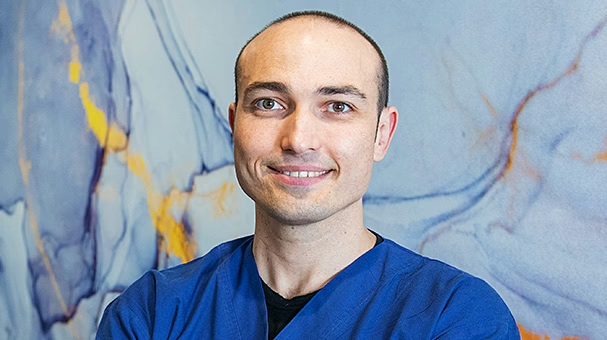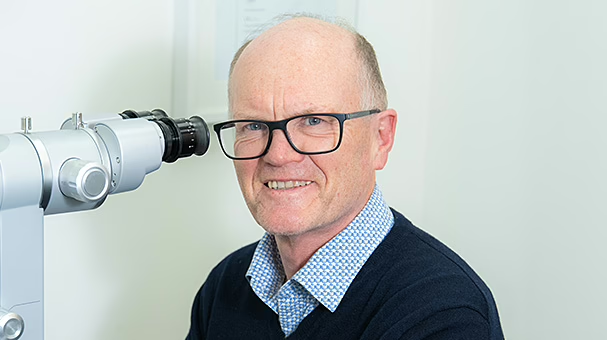Diagnosing glaucoma
A number of tests are carried out to diagnose glaucoma, including:
- Visual acuity (clarity) test using an eye chart
- Visual field test to determine peripheral vision
- An examination that involves using drops to dilate the pupils of the eye
- Tonometry to measure eye pressure
- Pachymetry to measure corneal thickness
- Gonioscopy to see if there is a blockage where the fluid normally drains out of the eye, and to distinguish between open-angle and closed-angle glaucoma
- Optical coherence tomography (OCT) to scan the optic nerve head to aid diagnosis and monitoring
Managing glaucoma
Unfortunately, there is no cure for glaucoma. But there are a number of treatment options available to help reduce eye pressure and minimise or prevent further vision loss. Sometimes a combination of glaucoma treatments may be used.
Medication
Eye drops are very effective in controlling eye pressure for most people with glaucoma.
Laser eye surgery for glaucoma
Laser eye surgery for glaucoma is performed in the clinic and does not require admission to a day surgery. Anaesthetic eye drops are used to numb the eye so there is little or no discomfort.
- Selective laser trabeculoplasty (SLT) uses laser pulses directed at the drainage outflow channels to stimulate the cells to clear away the debris and improve outflow, which in turn lowers the eye pressure. The laser is very safe, but its effect can wear off after a few years.
- YAG laser peripheral iridotomy is only used in angle-closure glaucoma to create a channel in the iris (coloured part of your eye), which opens up the drainage angle and prevents progression of the disease.2
Glaucoma surgery
Surgery is used for patients whose glaucoma continues to progress despite medication and laser treatment.
- Minimally invasive glaucoma surgery or MIGS (e.g. iStent, Hydrus and iTrack devices ) involves implanting a micro-stent into the drainage canal to bypass the outflow resistance. These are relatively new procedures to lower eye pressure and only require a small incision (like keyhole surgery) to insert the stent. They are characterised by their superior safety profile and short recovery period. In general, they work better in mild to moderate glaucoma.
- Minimally invasive Bleb surgery or MEBS (e.g. XEN or Preserflo) are implants that divert fluid into a ‘bleb’ or lake of fluid. They are less invasive and have a faster recovery time than traditional filtration surgery. Their long-term effectiveness is still under evaluation.
- Glaucoma filtration surgery (trabeculectomy) is the traditional surgery for glaucoma, having been used for many decades. A tunnel is created to allow fluid to bypass the outflow obstruction and drain out of the eye into a ‘bleb’. An anti-scarring agent (mytomycin C) is used to prevent closure of the new pathway. Trabeculectomy surgery is very effective but has a slow recovery period. It is reserved for patients with moderate to advanced glaucoma.
- Glaucoma drainage devices (Baerveldt, PAUL or Molteno) are relatively large drainage devices that are used to control eye pressure. The implant has a small tube that diverts fluid to a plate that sits on the surface of the eye, under the top eyelid. This procedure is usually reserved for advanced cases where a trabeculectomy is not suitable or has failed.
Clinic team
NSW
-
Dr Jason Cheng
BSc MBBS FRCOphth FEBO FAMS FRANZCO
Locations
- Hurstville
Book a consultationwith Dr Jason ChengQLD
SA
-
Dr Paul Athanasiov
MBBS FRANZCO MMed (OphthSc) MOphth
Locations
- North Adelaide Clinic
- Windsor Gardens
- Kurralta Park
Book a consultationwith Dr Paul AthanasiovDr Simone Beheregaray
MD PHD FRANZCO
Locations
- North Adelaide Clinic
- Windsor Gardens
Book a consultationwith Dr Simone BeheregarayVIC
-
Dr Uday Bhatt
MBBS DTMH DO MSc(EBP) FRCSEd FRCOphth FRANZCO
Locations
- Camberwell
- Coburg
- Footscray
Book a consultationwith Dr Uday BhattDr Jeremy Diamond
MB ChB, PhD, FRCS, FRCOphth, FRANZCO
Locations
- Boronia
Book a consultationwith Dr Jeremy DiamondDr Philip Hoffman
MBBS(First-class Hons) FRANZCO M Health Ethics Member of ANZSRS
Locations
- Camberwell
- Footscray
Book a consultationwith Dr Philip HoffmanDr Raj P Pathmaraj
MBBS DO MRCOphth MMed FRCSOphth FRANZCO
Locations
- Blackburn South
Book a consultationwith Dr Raj P PathmarajDr Aaron Yeung
MBBCh, PhD, FRCOphth, FRANZCO
Locations
- Footscray
Book a consultationwith Dr Aaron YeungResourcesThe information on this page is general in nature. All medical and surgical procedures have potential benefits and risks. Consult your ophthalmologist for specific medical advice.
Date last reviewed: 2025-02-11 | Date for next review: 2027-02-11
























